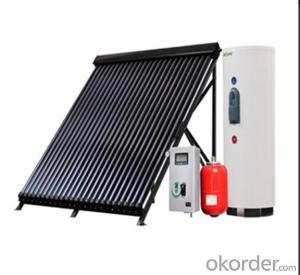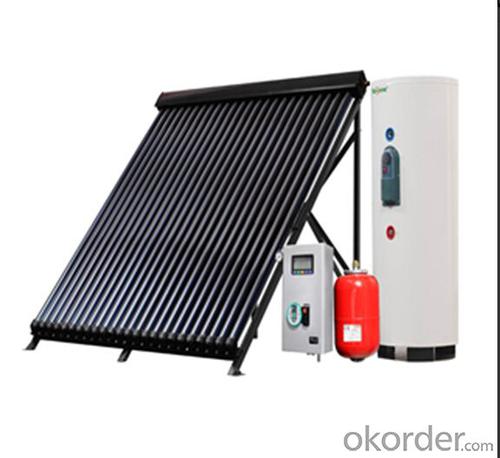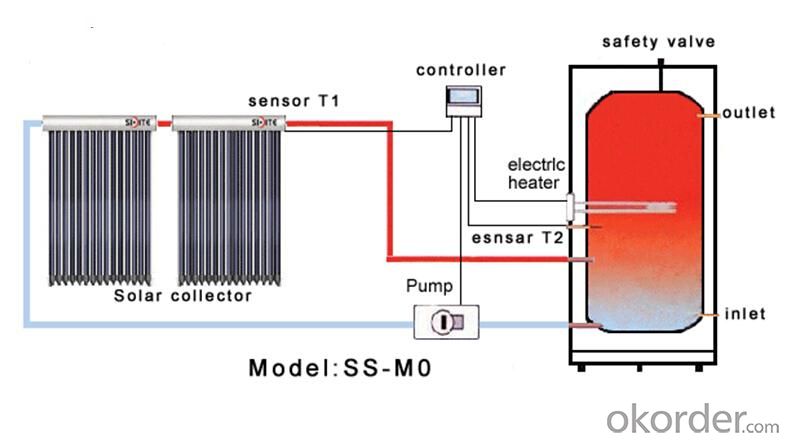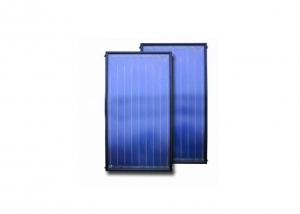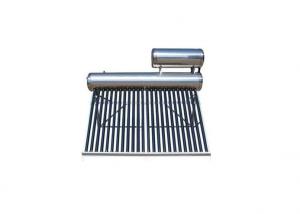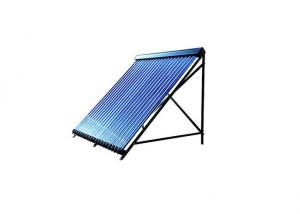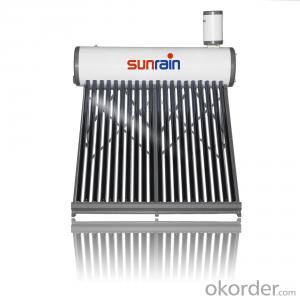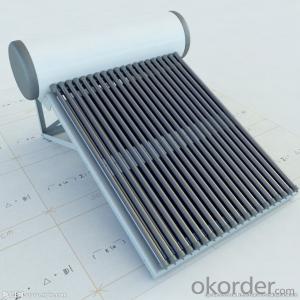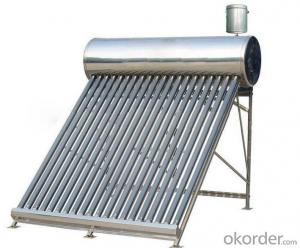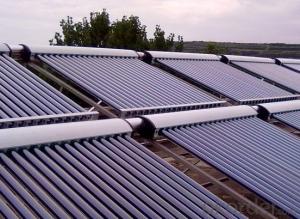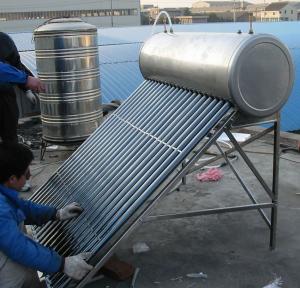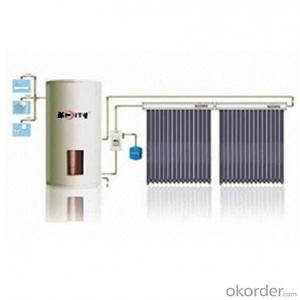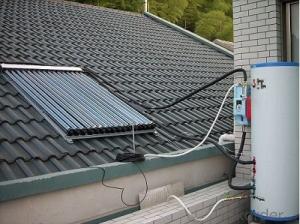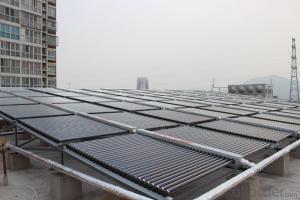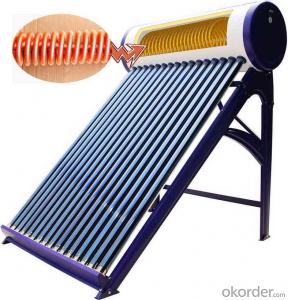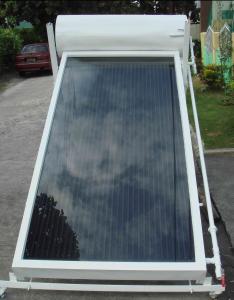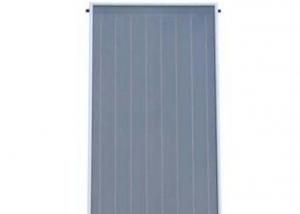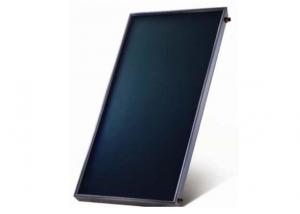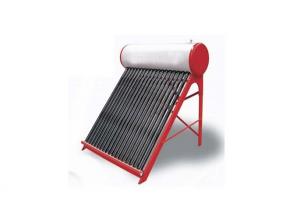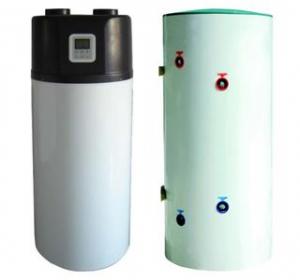Split Solar Heating System with no Copper Coil Inside of Water Tank Model SS-M0
- Loading Port:
- Shanghai
- Payment Terms:
- TT OR LC
- Min Order Qty:
- 20 set
- Supply Capability:
- 1500 set/month
OKorder Service Pledge
OKorder Financial Service
You Might Also Like
1. Structure of Split Solar Heating System with no Copper Coil Inside of Water Tank Model SS-M0
Split Solar Heating System with no Copper Coil Inside Water Tank Model SS-M0 is composed of solar collector, tank with no copper coil, working station and expansion tank, which are linked and controlled by the valves. Solar heating system is really a good supplement of gas or electricity, for when there is rich sunlight in summer, a correctly sized solar system can provide 60%-70% of a household's hot water needs and produces no environmental waste or pollution.
2. Main Features of Split Solar Heating System with no Copper Coil Inside Water Tank Model SS-M0
· Food-grade stainless steel SUS304-2B inner tank
· High heat transfer efficiency
· Combined with auxiliary electricity, gas and other boiler
· Easy installation according to the structure of the room
3. Split Solar Heating System with no Copper Coil Inside Water Tank Model SS-M0 Images (showing the working status and the installation instructure)
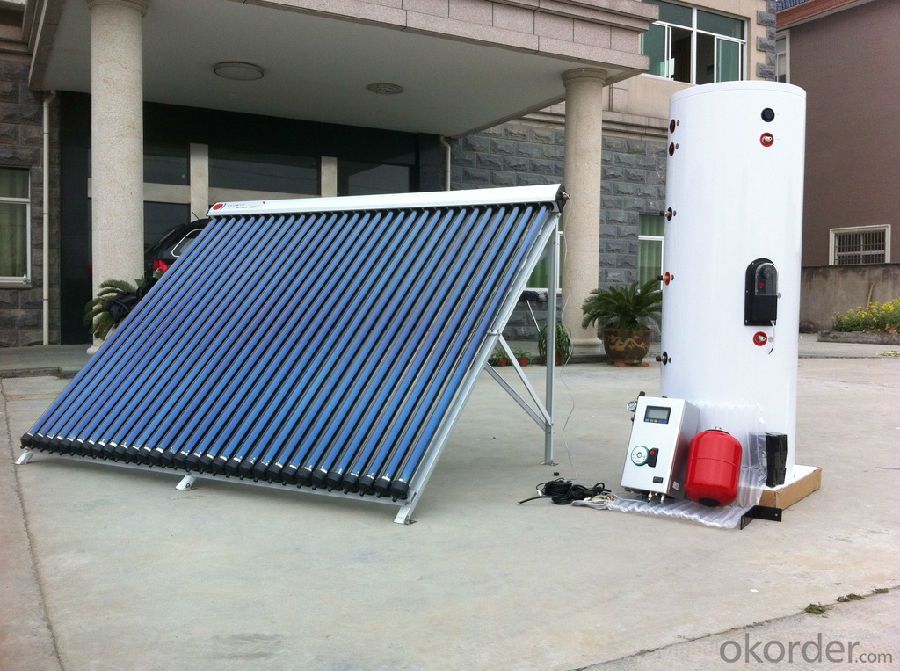
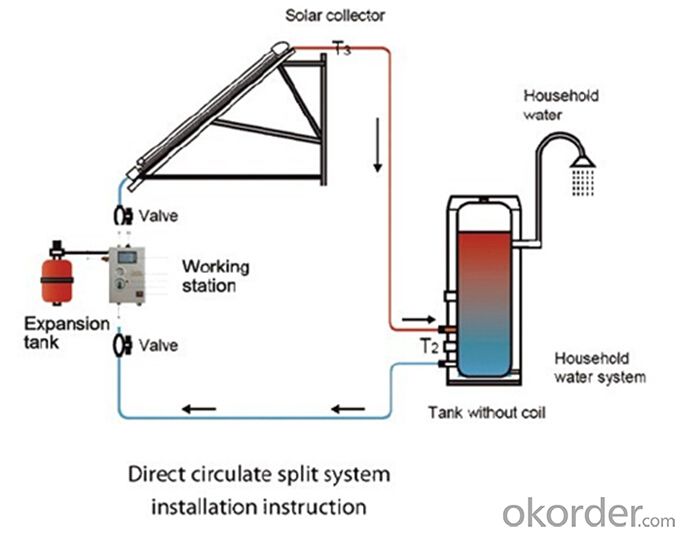
4. Split Solar Heating System with no Copper Coil Inside Water Tank Model SS-M0 Specification
System model | SS-M0-150 | SS-M 0-200 | SS-M 0-250 | SS-M0 -300 | SS-M 0-400 | SS-M0 -500 |
Tank capacity(L) | 150 | 200 | 250 | 300 | 450 | 500 |
Copper coil qty | 1/2 | 1/2 | 1/2 | 1/2 | 1/2 | 1/2 |
Solar collector model | SC-H-15/20 | SC-H-20/24 | SC-H-25/30 | SC-H-30/20 | SC-H-20/24 | SC-H-25/30 |
Solar collector qty | 1/1 | 1/1 | 1/2 | 1/2 | 2/2 | 2/2 |
Controller model | SR868C8 | SR868C8 | SR868C8 | SR868C8 | SR868C8 | SR868C8 |
Work station model | VSP-S1 | VSP-S1 | VSP-S1 | VSP-S1 | VSP-S2 | VSP-S2 |
Expansion tank spec | 12L | 12L | 18L | 18L | 24L | 24L |
Medium volume | 12L | 12L | 18L | 18L | 24L | 24L |
Recommended Flow | 1.0~2.0L/min | 1.2~2.5L/min | 1.5~3.0L/min | 3.0~5.0L/min | 4.0~7.0L/min | 5.0~8.0L/min |
Max temperature of tank | 95℃ | 95℃ | 95℃ | 95℃ | 95℃ | 95℃ |
Max temperature of system | 95℃ | 95℃ | 95℃ | 95℃ | 95℃ | 95℃ |
Rated pressure of the tank | 0.7MPa | 0.7MPa | 0.7MPa | 0.7MPa | 0.7MPa | 0.7MPa |
Media pre pressure | 0.2~0.3MPa | 0.2~0.3MPa | 0.2~0.3MPa | 0.2~0.3MPa | 0.2~0.3MPa | 0.2~0.3MPa |
Max pressure of system | 0.6MPa | 0.6MPa | 0.6MPa | 0.6MPa | 0.6MPa | 0.6MPa |
Voltage | AC220V 50Hz | AC220V 50Hz | AC220V 50Hz | AC220V 50Hz | AC220V 50Hz | AC220V 50Hz |
Recommended pipe diameter | φ15 | φ15 | φ15 | φ15 | φ22 | φ22 |
5. FAQ
1. Can the solar collectors be used in cold conditions?
Yes. Solar collectors of our company can be used under temperatures as low as -30℃, although performance is greatly reduced in such extreme conditions. Good heat output is still achieved in mild sub-zero conditions.
2. What happens if one of the solar tubes is broken?
Firstly, tubes are very strong and not easily broken, but if the worst should happen, solar tubes can be replaced very easily. The solar collectors of our company can operate with several broken tubes, but the efficiency will be reduced, so it is recommended that broken tubes be replaced immediately.
- Q: Is it possible to retrofit an existing water heater with solar panels?
- Yes, it is possible to retrofit an existing water heater with solar panels. By installing a solar water heating system, the existing water heater can be supplemented or even entirely replaced by solar energy. This can help reduce energy consumption and lower utility bills while promoting a more sustainable and environmentally friendly approach to heating water.
- Q: I am in the north, the winter is coming, the family of a solar water heater, solar water heater and a radiator to connect, realizes the indoor heating, there is no one to do this kind of transformation, how to realize the water cycle?Is there any way to reduce the carbon heating in the northern region in winter?
- 3, in order to ensure the stability of the temperature of the hot water system, also need to add a hot water storage tank, the excess heat storage when the sun is good, and then release the heat storage in solar energy shortage, to adjust the temperature of the hot water storage stability;4, the system needs to increase the circulation pump, the hot water tank in the hot water cycle, in order to ensure the end heating effect;
- Q: How does a solar water heater perform in cloudy or rainy weather?
- A solar water heater's performance is affected by cloudy or rainy weather as it relies on sunlight to heat the water. However, modern solar water heaters are designed to still produce hot water even in low sunlight conditions. They can utilize diffused or indirect sunlight, and some models even have backup heating elements to ensure a constant supply of hot water during cloudy or rainy periods.
- Q: Are there any fire hazards associated with solar water heaters?
- Yes, there are potential fire hazards associated with solar water heaters. These hazards can arise from electrical malfunctions, overheating of the system, or improper installation. However, when properly installed and maintained, the risks are minimal and can be effectively managed through safety measures and regular inspections.
- Q: Are there any financing options available for solar water heater installations?
- Yes, there are various financing options available for solar water heater installations. These include loans, leases, power purchase agreements, and government incentives such as tax credits and grants. These options can help make solar water heater installations more affordable and accessible for homeowners and businesses.
- Q: Can a solar water heater be used in areas with limited installation options?
- Yes, a solar water heater can be used in areas with limited installation options. Solar water heaters can be installed on rooftops, terraces, or even ground-mounted in open areas. They are flexible in terms of installation and can be adapted to fit various space constraints. Additionally, there are different types of solar water heaters available, such as integral collector-storage systems or thermosiphon systems, which may offer more installation options depending on the specific requirements of the area.
- Q: Can a solar water heater be used in areas with high levels of air pollution from mining activities?
- Yes, a solar water heater can still be used in areas with high levels of air pollution from mining activities. Solar water heaters rely on sunlight to heat water, so as long as there is sufficient sunlight reaching the solar panels, the system can function effectively. However, it is important to regularly clean and maintain the solar panels to prevent dust and debris from reducing their efficiency.
- Q: What are the requirements for the installation of solar water heaters?Why do you install this?
- In the case of sunny, the first water or water tank for more than 15 minutes without water, during the day can not Sheung Shui, or because of dry air drying up to a high temperature of up to 270 degrees, vacuum glass tube will burst due to sudden cold. Preferably in the evening or morning before sunrise water, during the day really need to Sheung Shui, the need to cover the heat collector after an hour of water. In the winter cold areas, to prevent cracking pipes. The utility model relates to a solar water heater without an auxiliary heating device, which should be stopped when the utility model is particularly cold.
- Q: Can a solar water heater be used in areas with high levels of air pollution?
- Yes, a solar water heater can be used in areas with high levels of air pollution. The efficiency of the system may be slightly affected due to reduced sunlight reaching the solar panels, but it can still generate heat and provide hot water. Regular cleaning and maintenance of the solar panels may be necessary to ensure optimal performance in such environments.
- Q: Can a solar water heater be used in areas with high levels of water turbidity?
- Solar water heaters are generally not recommended for areas with high levels of water turbidity. The presence of particles and impurities in the water can reduce the efficiency and effectiveness of solar water heaters. These particles can block or coat the surface of the solar collector, preventing sunlight from reaching the water and hindering heat transfer. Therefore, it is preferable to use alternative water heating methods in areas with high water turbidity.
Send your message to us
Split Solar Heating System with no Copper Coil Inside of Water Tank Model SS-M0
- Loading Port:
- Shanghai
- Payment Terms:
- TT OR LC
- Min Order Qty:
- 20 set
- Supply Capability:
- 1500 set/month
OKorder Service Pledge
OKorder Financial Service
Similar products
Hot products
Hot Searches
Related keywords
